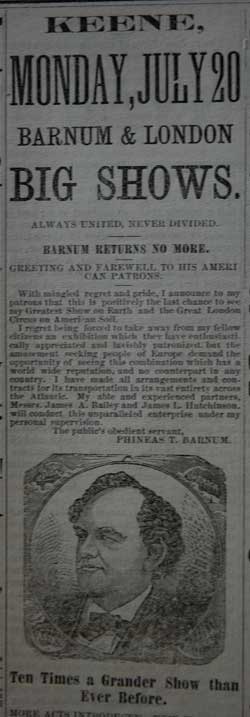 Only it wasn’t really the “campus” at the time, and it was even several years before there would be a Keene Normal School, let alone a Keene State College. Anyway, on July 18, 1885, the Barnum, Bailey, and Hutchinson Circus was in Nashua. It’s next stop was Keene, to provide the locals with the biggest entertainment event of the year.
Only it wasn’t really the “campus” at the time, and it was even several years before there would be a Keene Normal School, let alone a Keene State College. Anyway, on July 18, 1885, the Barnum, Bailey, and Hutchinson Circus was in Nashua. It’s next stop was Keene, to provide the locals with the biggest entertainment event of the year.
Unfortunately, Albert, a huge bull Indian elephant (second in size only to Barnum’s fabled Jumbo), got in a tiff with another elephant. When elephant-trainer John McCormack stepped in to break up the fight, Albert knocked McCormack down and pinned him to the ground with his massive head. Then Albert bolted from the scene, onto the circus grounds, and could have caused considerable damage, were it not for the brave intervention of Prof. Astingstall, “the celebrated keeper and trainer who faced and subdued the brute in his mad rush.”
The circus doctor examined McCormack and found no broken bones, so everyone thought the trainer would recover, but he died of internal injuries during the train ride to Keene. By the time the train reached Keene, the circus owners decided that Albert was too great a risk, and needed to be put down.
The circus grounds were between Appian Way and the Ashuelot River, on what is now the KSC campus. The elephants always loved visiting Keene, because they got to play in the river. But not poor Albert. He was confined under heavy guard while his fellow pachyderms enjoyed a bath.
Thirty members of the Keene Light Guard under Capt. Francis Nims volunteered for the firing squad. Reports of the day claim that Albert was heavily chained to trees in a ravine on the east side of the Ashuelot, between Appian Way and Appleton St. Over 500 people gathered to watch as Prof. Astingstall drew two chalk circles on Albert: one over his heart, and one behind his eye. On Capt. Nim’s order to fire, 30 rifles rang out as one, and Albert slumped to the ground with a final moan.
Two representatives from the Smithsonian Institution arrived to accept the donation of the animal’s skin and bones. That evening, the Cheshire House, which stood on Main St. near Central Square and was famous for its exotic fare, served elephant steaks to its discriminating guests. Campus legend has it that whatever was left of Albert was buried where he fell, but where might that be?
Those elephant steaks must have been pretty darn good, because Morgan Sherman, proprietor of the Cheshire House, had a small stone marker set up that said, “Erected to the memory of the elephant, Albert, shot on this spot July 21, 1885, for killing his keeper at Nashua.” So where’s the marker? Clifford C. Wilber, in his Oct. 3,1935, column, “The Good Old Days,” in the Keene Sentinel, said that the marker was long gone even then. Souvenir hunters chipped pieces of it away, and, according to Wilber, “Many years ago the river was diked in the vicinity of the marker and some have thought that the stone became buried during these operations.”
Take a look at the campus map and you’ll see that the only section of the river with an east bank between Appian Way and Appleton St. (where Albert’s execution reportedly took place), is the short stretch behind Pondside I and the Redfern. After that, the river makes an abrupt turn to the west. So it’s likely that the marker, and whatever wasn’t mounted or eaten of Albert, is somewhere under Brickyard Pond, or maybe under the Redfern. Legend has it that he’s under the pond; I’m going with that.

Thanks for this article Mark. It is good to read about Keene’s community history and it explains the strange sounds that sometimes come from the Music Department.
This was fun to read about. Thanks!
1835. The brick yard was a going large pit.
Often half full of water.
So, no elephant.
Probably under the World War II soft coal pile.
In the 1950’s that right field area often flooded.
A long fly ball, hit to right field, landed up on the coal pile.
Right fielder Sanders(?), usually shreaded his pants.
KenYoung